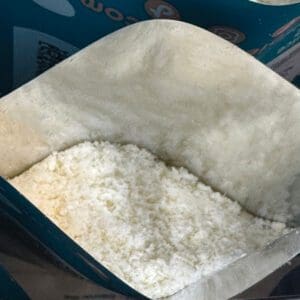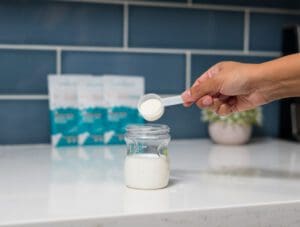Does freeze-drying help with lipase? Lipase is an enzyme naturally present in breast milk that can cause changes in taste and smell, affecting the overall quality of stored milk. Managing lipase activity is important for mothers who plan to store their breast milk for later use. In this article, we will explore various methods to stop lipase in breast milk and ensure long-term storage without compromising taste or quality.
Key Takeaways:
- Lipase is an enzyme found in breast milk that can impact taste and smell.
- High lipase activity can lead to changes in stored breast milk.
- Techniques such as scalding and freeze-drying can inhibit lipase before storage.
- Scalding milk involves heating and rapidly cooling breast milk to deactivate lipase.
- Freeze-drying removes water content through sublimation, halting lipase activity for long-term storage.

Understanding Lipase Activity in Breast Milk
What is Lipase?
Lipase is an enzyme naturally found in breast milk that plays a crucial role in breaking down fats. It aids in digestion and ensures that the baby receives essential nutrients for growth and development.
The Role of Lipase in Breast Milk
Lipase is one of the several enzymes present in breast milk, and its primary function is to hydrolyze triglycerides into free fatty acids and glycerol. This breakdown of fats facilitates their absorption by the baby’s digestive system, promoting proper digestion and nutrient absorption.
Identifying High Lipase
In some cases, lipase activity in breast milk can be higher than usual, resulting in changes in taste and smell when the fresh milk is stored. While it aids in a baby’s digestion, this elevated lipase activity can lead to a metallic or soapy odor and taste, making the milk less palatable for the baby.
Identifying high lipase activity is essential for mothers who plan to store their breast milk for future use. By understanding whether their breast milk has high lipase activity, they can take appropriate steps to prevent the negative effects of lipase on the stored milk’s taste and smell.
Impact of High Lipase on Breastfeeding and Storage
Effect on Taste and Smell
High lipase activity in breast milk can have a significant impact on the taste and smell of the milk. When lipase activity is elevated, the milk may develop a soapy or metallic taste and an unpleasant odor. These changes in taste and smell can be off-putting to the baby, leading to rejection of the milk and difficulties with breastfeeding. It is important for mothers to be aware of these effects and take measures to mitigate them.

Storage Challenges for Breast Milk with High Lipase
Storing breast milk with high lipase activity can present several challenges. The increased lipase activity can cause the milk to become rancid faster over time, resulting in an unpleasant taste and sour smell. This can make it less palatable for the baby and may lead to wasted milk.
Furthermore, high-lipase breast milk may also interact with storage containers, potentially leading to an altered flavor and decreased quality of the milk. To ensure the longevity and quality of stored breast milk, it is important to address the challenges posed by high lipase activity.
Techniques to Inhibit Lipase Before Storage
Mothers who plan to store their breast milk for longer durations can utilize various techniques to inhibit lipase activity and preserve the taste and quality of the milk. These methods aim to ensure that the stored milk remains fresh and palatable for the baby. Here are some common techniques to consider:
- Scalding the Milk: Scalding breast milk involves heating it to a specific temperature and quickly cooling it down. This process denatures lipase, preventing it from breaking down fats and reducing its impact on taste and smell.
- Freeze-Drying Breast Milk: Freeze-drying deactivates lipase enzymes from functioning by removing water required by the enzymes cells to function. Freeze-drying also is known to improve the taste and aroma of milk already affected by high lipase enzymes.
The sooner you scald your milk or freeze-dry your milk, the less overall impact lipase will have on your milk. Freeze-drying is known to improve the overall taste and aroma of already impacted lipase milk, and improvements will be greatly based on how impacted your milk is at the time of freeze-drying. Keep a frozen pouch of your older high-lipase milk to compare the difference.
Scalding Milk: A Method to Deactivate Lipase
Lipase deactivation is crucial for maintaining the quality of stored breast milk, and one common technique utilized by many mothers is scalding. Scalding a mother’s milk involves heating it to a specific temperature and then rapidly cooling it. This process effectively denatures the lipase enzyme, preventing lisapse from breaking down nutrition taste and smell changes that can occur during storage.
Step-by-Step Guide to Scalding Breast Milk
- Pour the expressed breast milk into a clean and sterilized container.
- Place the container in a pot or pan filled with water. Ensure that the water level is below the level of breast milk to avoid any contamination.
- Heat the water on a stove over medium heat until it reaches a temperature of approximately 180°F (82°C). Use a food thermometer to accurately measure the temperature.
- Once the breast milk reaches the desired temperature, remove the container from the heat source immediately to prevent overheating.
- Place the container in a bowl or sink filled with ice water. This rapid cooling process stops the heating and deactivating process.
- After the milk has completely cooled, transfer it to clean storage containers and label them with the date and time of expression.
Safety Precautions and Best Practices
When scalding breast milk, it is important to keep the following safety precautions and best practices in mind:
- Always use clean and sterilized containers to prevent contamination.
- Monitor the temperature of the water closely to prevent overheating or scorching the milk.
- Use a food thermometer to ensure accurate temperature measurement.
- Do not leave the milk unattended during the scalding and cooling process.
- Rapidly cool the milk using ice water to ensure proper deactivation of lipase.
- Properly label the stored human milk with the date and time of expression for easy tracking and rotation.
By following this step-by-step guide and adhering to the safety precautions, mothers can effectively deactivate lipase in breast milk through the scalding method. This ensures that the frozen milk maintains its nutritional value and taste, providing a quality feeding experience for their babies.
Freeze-Drying Breast Milk Halts Lipase Enzyme
Freeze-drying is an effective method for long-term storage of breast milk. This process halts the activity of the lipase enzyme, ensuring that the milk retains its taste and quality over time. By removing the water content from the milk, freeze-drying prevents lipase from causing changes in smell and taste. It is also known to improve the taste and aroma of freshly pumped milk, already affected by lipase enzymes.
Freeze-dried breast milk can be stored for an extended period without compromising its nutritional value. This makes it a convenient option for mothers who want to ensure a steady supply of high-quality milk for their babies. Whether due to a busy schedule, medical reasons, or personal choice, freeze-drying breast milk provides a reliable solution for long-term storage. Freeze-dried breast milk can even be sprinkled over solid foods for an added nutritional boost.

Summarizing Lipase Inhibition Strategies
Managing lipase activity in breast milk is important for breastfeeding mothers who plan to store their milk. By implementing effective lipase inhibition techniques, such as scalding or freeze drying, mothers can ensure the quality and taste of stored breast milk. These strategies are essential in preserving the nutritional value of the milk and providing a pleasant feeding experience for the baby.
